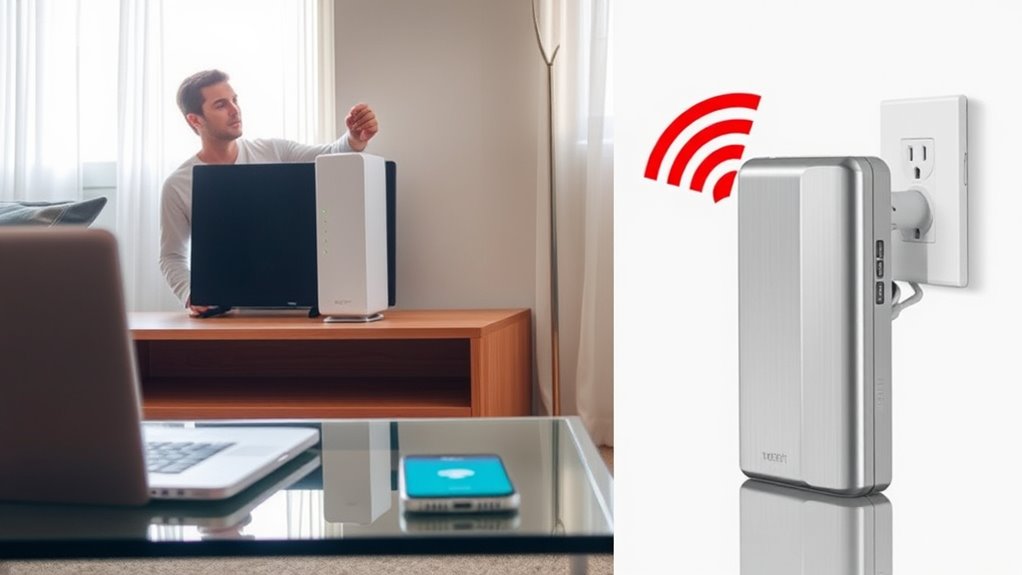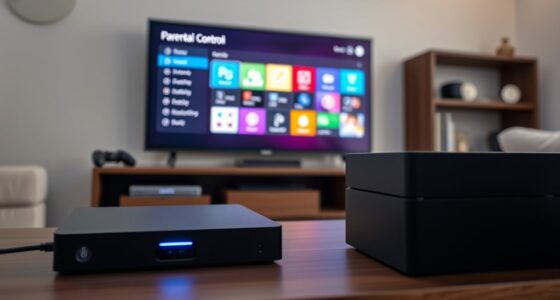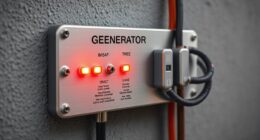To boost your home Wi-Fi, start by placing your router in a central, high spot, ideally on a shelf or table, away from thick walls and electronic interference. Upgrade antennas or switch to higher-gain versions, and experiment with their angles for better coverage. Use the 5 GHz band for faster speeds in busy areas and select less crowded channels. Consider upgrading to mesh systems or adding extenders if needed. Keep firmware updated, and optimize your setup—learn more to maximize your signal.
Key Takeaways
- Position your router centrally and elevate it to reduce obstacles and ensure even coverage throughout your home.
- Adjust and optimize antenna angles or upgrade to high-gain antennas for better signal reach and strength.
- Use the 5 GHz band for faster speeds in crowded areas and select less congested channels to minimize interference.
- Minimize physical barriers and electronic interference by relocating devices and keeping the router away from thick walls and metal objects.
- Upgrade hardware, such as supporting Wi-Fi 6/6E, and consider mesh systems or extenders for seamless, extensive coverage.

Struggling with slow or unreliable Wi-Fi in your home? You’re not alone. The good news is, a few strategic adjustments can noticeably boost your signal strength and stability. First, focus on where you place your router. Position it in a central spot within your home to maximize coverage, and elevate it off the floor—preferably on a high shelf or table—to reduce signal obstruction. Avoid placing it near thick walls or large metal objects, as these materials absorb or block wireless signals, weakening your connection. Keep it away from electronic devices like microwaves or cordless phones, which can cause interference. Also, make sure the router antennas are oriented properly; positioning antennas perpendicular to each other helps distribute the signal more evenly across your space.
Optimize your Wi-Fi by central placement, elevating the router, and proper antenna orientation for better coverage.
Next, consider how you adjust and upgrade your antennas. For routers with multiple antennas, angle them to cover different axes—one vertically, one horizontally—to improve coverage. Experiment with antenna angles using speed tests to find the best configuration. If possible, replace the standard antennas with higher-gain versions to extend your signal’s reach and quality. Some routers have external, adjustable antennas or support external high-performance options, giving you more control over your wireless coverage.
Switching between frequency bands is another effective way to enhance your Wi-Fi. Use your dual-band router’s capabilities to toggle between 2.4 GHz and 5 GHz, depending on your needs. The 5 GHz band offers faster speeds and less interference, making it ideal for streaming and gaming, especially in crowded neighborhoods. Keep in mind that the 5 GHz and newer 6 GHz (Wi-Fi 6E, Wi-Fi 7) bands have shorter effective ranges, so stay close to your router when using these frequencies. The 2.4 GHz band, while offering longer range, tends to be slower and more prone to interference from household devices.
Adjusting your Wi-Fi channels can also make a big difference. Use your router’s settings to select less crowded channels—on the 2.4 GHz band, channels 1, 6, or 11 typically minimize overlap. Regularly scan for neighboring networks to find the clearest channels on both bands, reducing interference and increasing throughput. Additionally, reduce household interference by relocating devices that operate on similar frequencies away from your router and connected devices.
Optimizing your wireless signal quality can significantly enhance your overall network performance. Hardware upgrades can dramatically improve your Wi-Fi experience. Upgrade your device’s wireless adapters or network cards to support newer standards like Wi-Fi 6 or Wi-Fi 6E. Keep your router’s firmware and device drivers up to date to guarantee peak performance and security. If your home is large or multi-story, consider investing in a mesh Wi-Fi system for seamless coverage or adding range extenders or repeaters to boost weak spots. Minimizing physical barriers—like thick walls, floors, or large metal furniture—and ensuring proper ventilation around your router also help prevent signal degradation. With these steps, you’ll enjoy faster, more reliable Wi-Fi throughout your home.
Frequently Asked Questions
Can Upgrading My Router Significantly Boost Wi-Fi Speed?
Upgrading your router can considerably boost your Wi-Fi speed if you choose a model supporting the latest standards like WiFi 6 or WiFi 7. These routers offer faster speeds, better range, and improved reliability, helping your devices perform better. However, remember that your internet plan‘s speed still limits overall performance. You’ll see the biggest benefits if your devices and internet plan are compatible with your new router’s advanced features.
Do Wi-Fi Extenders Reduce Overall Internet Speed?
Your Wi-Fi experience isn’t a rollercoaster; it’s more like a battlefield, and Wi-Fi extenders can actually slow you down. They relay signals, which often halves your speeds and adds latency. While they extend coverage, the speed loss can be significant, especially if placed poorly. To keep things speedy, consider strategic placement or alternatives like mesh networks or wired connections for the best, lightning-fast connectivity.
How Often Should I Replace My Wi-Fi Router?
You should consider replacing your Wi-Fi router every 3 to 5 years. If you notice slow speeds, frequent disconnections, or security issues, it’s time for an upgrade. Heavy usage and newer Wi-Fi standards also call for more frequent replacements. Upgrading ensures better security, improved performance, and compatibility with your devices. Keep an eye on firmware updates and physical damage to decide the right time to replace your router.
Can Wall Materials Affect Wi-Fi Signal Strength?
Walls act like silent gatekeepers, quietly blocking your Wi-Fi’s voice. Metal, concrete, and brick walls serve as formidable barriers, muffling your signal like a thick fog. In contrast, wooden and glass walls let your Wi-Fi dance freely through, whispering seamlessly. So, yes, your wall materials can dramatically influence your connection, turning a smooth stream into a choppy current. Understanding this helps you find better spots and solutions for stronger Wi-Fi.
Is It Better to Use a Wired Connection Instead of Wi-Fi?
Using a wired connection is generally better if you want faster, more reliable internet. You get higher speeds, lower latency, and fewer interruptions compared to Wi-Fi. Wired setups are ideal for activities like gaming, streaming, or large file transfers, where stability matters most. While Wi-Fi offers convenience for mobility and multiple devices, a wired connection guarantees consistent performance, especially for demanding tasks or stationary devices.
Conclusion
Now that you’ve learned how to boost your Wi-Fi, your connection will feel like a steady stream of sunlight breaking through cloudy skies. No more frustrating drops or dead zones—just smooth, reliable internet flowing effortlessly through your home. Think of your Wi-Fi as the heartbeat of your digital life; with these tips, it’ll beat stronger and faster, keeping you connected and empowered. Embrace the upgrade and turn your home into a sanctuary of seamless connectivity.










